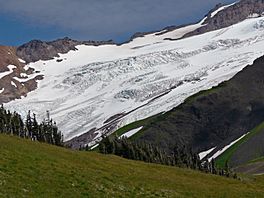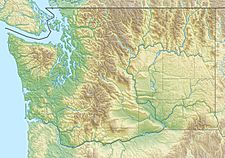Roosevelt Glacier facts for kids
Quick facts for kids Roosevelt Glacier |
|
|---|---|
 |
|
| Type | Mountain glacier |
| Coordinates | 48°47′25″N 121°49′43″W / 48.79028°N 121.82861°W |
| Length | 2 mi (3.2 km) |
| Terminus | Icefall/cliffs/talus |
| Status | Retreating |
The Roosevelt Glacier is a large ice mass found on the north side of Mount Baker. Mount Baker is a tall mountain located in the North Cascades mountain range. This range is in the state of Washington, which is in the USA.
Glaciers are like very slow-moving rivers of ice. They form when snow falls and builds up over many years. The weight of the new snow presses down on the old snow, turning it into ice. This ice then slowly flows downhill because of gravity.
Contents
Discovering Roosevelt Glacier
The Roosevelt Glacier is named after a famous person, but the exact reason for its name isn't widely known. It's one of many glaciers on Mount Baker. Mount Baker is a volcano, but it's also covered in a lot of ice and snow.
People have been studying glaciers like Roosevelt Glacier for a long time. Scientists watch them to understand how Earth's climate is changing.
Where is Roosevelt Glacier?
Roosevelt Glacier is located in Whatcom County, Washington. This area is known for its beautiful mountains and forests. The glacier sits high up on Mount Baker. It is part of the amazing natural beauty of the North Cascades.
The glacier flows down the mountain to an elevation of about 5,000 ft (1,500 m). This lower part of the glacier is called the Chromatic Moraine. A moraine is a pile of rocks and dirt that a glacier leaves behind as it moves.
How Big is Roosevelt Glacier?
Roosevelt Glacier is about 2 mi (3.2 km) long. That's like walking two miles! It's a significant size for a mountain glacier.
In the middle of its path, Roosevelt Glacier connects to another glacier called Coleman Glacier. They are like two icy rivers that meet up on the mountain. This connection shows how complex and connected the ice systems on Mount Baker are.
What is Happening to the Glacier?
Scientists have observed that Roosevelt Glacier is currently "retreating." This means it is getting smaller and shrinking back. Many glaciers around the world are retreating. This is often due to warmer temperatures caused by climate change.
When a glacier retreats, it can affect the environment around it. For example, it can change the amount of water flowing into rivers and streams. This water is important for plants, animals, and even people living nearby.
Why are Glaciers Important?
Glaciers like Roosevelt Glacier are very important for several reasons:
- Water Supply: They store a lot of fresh water. When the ice melts slowly, it provides water to rivers and lakes, especially during dry seasons.
- Climate Indicators: Glaciers are like natural thermometers. Their size and movement can tell scientists a lot about how Earth's climate is changing over time.
- Ecosystems: The meltwater from glaciers creates unique habitats for plants and animals.
- Beauty: Glaciers are also incredibly beautiful and attract many visitors to national parks and wild areas.
Studying Roosevelt Glacier helps us understand the health of our planet. It shows us how important it is to protect our environment for the future.


